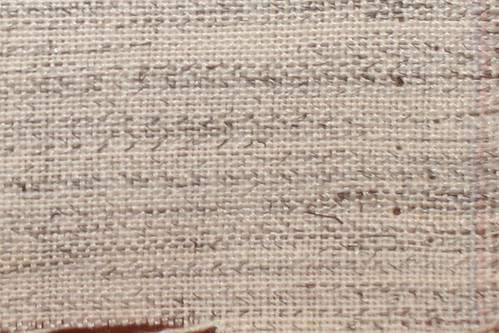
A brief heads-up for the tailors out there.
I've been seeing some of what I consider to be inferior quality canvas cropping up and if you're not accustomed to looking for this, you may not notice it. So next time you are shopping canvas, bring a loupe or a magnifying glass.
The canvas is woven from yarns which are twisted; the animal hair will be mixed with wool, cotton, and maybe other fibers and twisted to make a yarn. The springiness of the animal hair, when twisted, will cause the yarn, and thus the canvas, to want to curl. To counter this, quality canvas is woven using what we call S and Z yarns (the shape of the letters gives you an idea of what this means); the yarn is twisted in one direction to create the S yarn, and the Z yarn is made by twisting in the opposite direction. This balances the canvas, but is more expensive than making, stocking, and using only one kind of yarn so certain weavers, mainly located in parts of the world which are new to weaving canvas (ahem) are cheating by only using one type of yarn. If you look at the photo above you can see a bit of the chevron which indicates that the weave is balanced.
If you're making up some heavy tweed or English flannel it probably won't matter, but if you're cutting something softer or lighter I would definitely take a closer look at the canvas you are buying.








5 comments:
Would you happen to be able to point me to a reference for all the underpinning materials used in tailoring? I learned tailoring for women's suits, and came out of my quasi-apprenticeship knowing hair canvas, and that there were different weights and qualities of it. But it's becoming painfully clear as I read tailoring blogs that I have no idea what's going on.
I get lost on the differences among hair cloth, hair canvas, hymo, all the varieties of felt, flannels, and sundry underlinings. Accordingly, I am fairly sure I'm making horrible errors in building - things like putting the wrong layer next to the jacket fabric.
BTW, if you were ever to write a book, even if it was a print compilation of your blog, I would totally buy it.
Oops- missed this question.
Well, Malwae, if one thing should be clear from all these dissections, it’s that there are as many ways of constructing a coat front as there are tailors, and the types of canvas and the way you cut them are what each tailor or designer must determine for themselves in order to achieve the look and feel that they want. A few basics, though.
Your coat front should be cut in a good-quality wool-warp canvas in the 180- 200 gram range. The weight should, of course, match the weight and consistency of the cloth.
What you put in the chest is up to you- wrapped hair will be softer but heavier than haircloth. Haircloth provides better support. You definitely want a piece of haircloth in the shoulder, cut on a slight bias. When selecting haircloth, see if you can easily shift the cotton warp fibers along the hair, pulling apart along the weft. If they shift and you get a bit of an opening, skip it- this type will migrate easily and end up poking through. The weave should be locked in due to a slight crimp in the hair and feel quite solid.
Then you need a piece of felt or flannel to cover this so the hairs don’t poke through. I prefer wool felt but there are other, cheaper alternatives. To gauge the quality, though, take a mechanical pencil and poke the felt gently; if it pierces the felt easily, choose something else as it won’t provide good coverage.
congrats! keep up the good work/this is a great presentation.
Interesting blog. It would be great if you can provide more details about it. Thanks you.
Thank you, Sonica.
You would like more details about what, exactly?
best
J
Thanks for the info - that's actually very helpful. I have to order everything online, so I'm never sure what I'm getting - it's good to have an idea of how to assess the usefulness of what I get.
Post a Comment